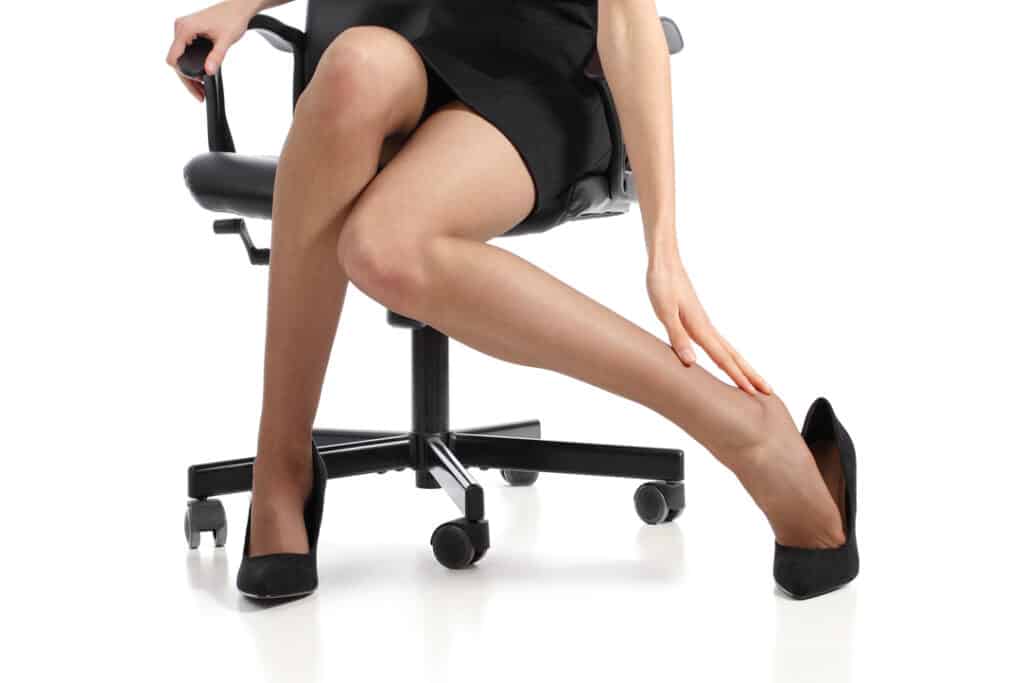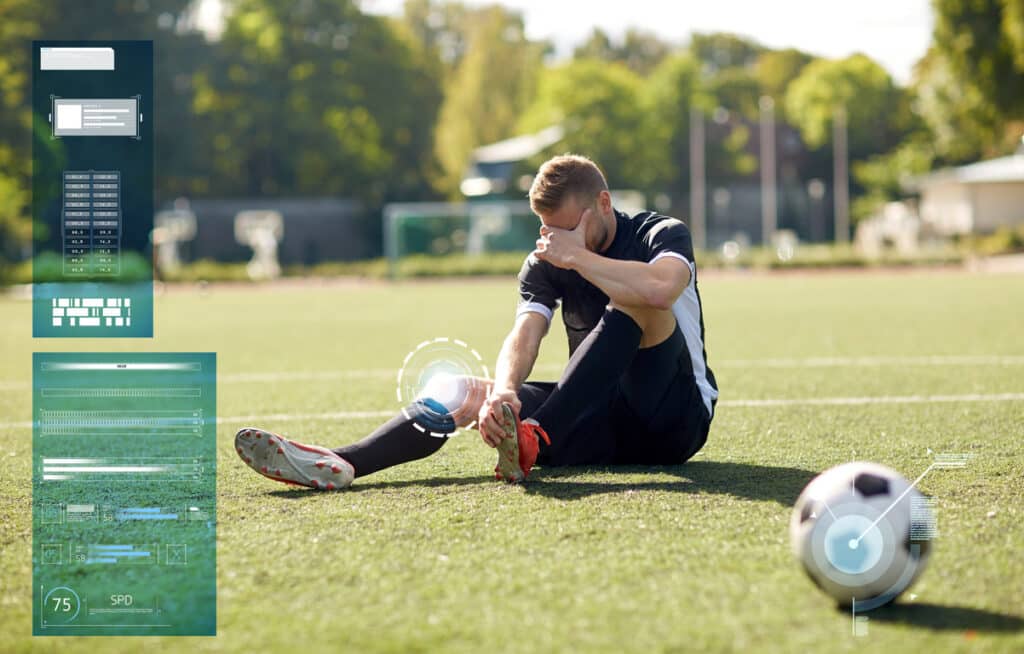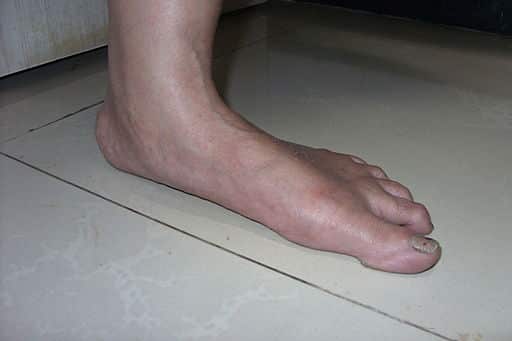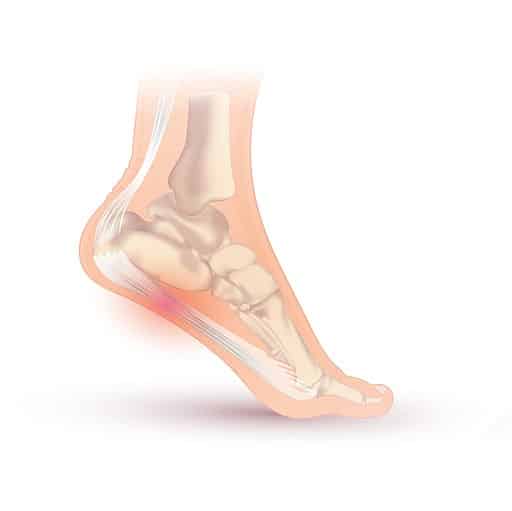What Is Heel Pad Syndrome?
Heel pad syndrome appears when the fatty pouch that cushions your heel becomes inflamed.
It causes deep, bruise-like pain, usually triggered by standing, walking, or running.
Treatment options focus on relieving the pain through rest, cold therapy, and supportive heel cups and soles.
Heel Fat Pad Function
Fat pads are pockets of fat cells, held together by strong but stretchy fibers.
You can find them at your elbows and knees, as well as the soles of your feet.
Fat pads absorb any direct impact, protecting the structures underneath.

Your feet handle a lot of mechanical stress every day.
Whenever you’re walking, running, or just standing, most of your body weight falls on the heel.
Your heel pad works like a cushion, absorbing the impact of daily activities.
Over time, it’s normal for your heel pads to go through wear and tear. Eventually, this microtrauma can bring about heel pad pain.1Grigoris Grigoriadis, Nicolas Newell, Diagarajen Carpanen, Alexandros Christou, Anthony M.J. Bull, and Spyros D. Masouros⁎
. Material properties of the heel fat pad across strain rates
, J Mech Behav Biomed Mater. 2017
Heel Pad Syndrome: Common Symptoms
When the protective layer at your heels becomes thinner and more fragile, it doesn’t absorb stress as effectively. This leads to heel pad pain.

The most common symptom is deep pain in the middle of your heel.
Heel Pad Pain
Heel pad pain is bruise-like, and it gets worse with pressure.
At first, the pain might only appear after a prolonged impact on your heel.
For example, you might feel it after going out for a run or when you walk barefoot.
Over time, less intensive activities like walking or standing might also become painful.
What Causes Heel Pad Syndrome?
Your feet are one of the most complicated and elegant structures in your body.
From fatty tissue and ligaments to endure pressure to an arch that acts like a spring, the feet are small biomechanical wonders.

But, the complex structure of the foot also means that when pain appears, there are many possible causes.
Trauma and Inflammation
Your heel pad works near its’ physiological maximum even when you’re walking.2Scott C Wearingcorresponding and James E Smeathers <a href= “https://www.ncbi.nlm.nih.gov/pmc/articles/PMC3102920/” target=” _blank”>The heel fat pad: mechanical properties and clinical applications,</a> Journal of Foot and Ankle Research. 2011
Over time, these tough working conditions can cause small tears in the tissue.
Microtrauma and inflammation are the most common causes of heel pad pain.
But many factors increase your risk of injury and pain:3PRISCILLA TU, DO,. Heel Pain: Diagnosis and Management, Am Fam Physician. 2018
- Poor gait and posture
- Ill-fitting shoes
- Excess body weight
- Bruised heel, a fat pad trauma caused by overuse (e.g., after a long-distance run)
Fat Pat Atrophy
Atrophy means that your fat pad becomes thinner and less effective at absorbing mechanical stress.
This can cause pain and inflammation, as well as callus formation. Some fat pad thinning is normal as we age.
But, conditions like type II diabetes can increase the risk of atrophy.

By maintaining a healthy weight and keeping your blood sugar in check, you can lower your chances of heel pain.4Sunit Dalal, Alan D Widgerow, Gregory R D Evans <a href=”https://pubmed.ncbi.nlm.nih.gov/24131727/?from_term=fat+pad+atrophy&from_pos=6” target=”_blank”>The Plantar Fat Pad and the Diabetic Foot–A Review,</a> International Wound Journal. 2015
Haglund’s Deformity
Haglund’s deformity (also known as “pump bump”) is a bony enlargement at the back of your heel.
The friction between the bump and your Achilles tendon can cause pain, redness, and swelling in the area.5Stephens MM
. Haglund’s deformity and retrocalcaneal bursitis.
, The Orthopedic Clinics of North America. 1993
Sever Disease
Sever disease is an inflammation of the growth plate (apophysis) of the calcaneus in children and adolescents.
As the Achilles tendon pulls on the bone, it causes small injuries to the apophysis.
This leads to inflammation and heel pain. Walking and running make the pain worse.
Usually, once bone growth completes, the symptoms disappear.6Denise R Ramponi, Caron Baker
. Sever’s Disease (Calcaneal Apophysitis)
, Adv Emerg Nurs J
. Jan/Mar 2019
Heels Pad Syndrome vs. Plantar Fasciitis
The plantar fascia is a thick ligament that connects the front of your foot with your heel.
It supports the arch of your foot and handles the pressure from your body weight when standing.
Much like the heel pad, your plantar fascia is under a lot of mechanical stress every day.
Over time, this can cause small tears and inflammation, a condition known as plantar fasciitis.
Plantar fasciitis is the most commonly diagnosed cause of heel pain.
Unlike heel pad syndrome, plantar fasciitis pain:
- Appears first thing in the morning (first-step pain.)
- Usually affects only one foot (unilateral pain.)
- Aches, but rarely burns or tingles.

Walking provides relief for plantar fascia pain but causes heel pad pain.7Tae Im Yi, M.D., Ga Eun Lee, M.D., In Seok Seo, M.D., Won Seok Huh, M.D., Tae Hee Yoon, M.D., and Bo Ra Kim, M.D. <a href= “https://www.ncbi.nlm.nih.gov/pmc/articles/PMC3309235/” target=” _blank”>Clinical Characteristics of the Causes of Plantar Heel Pain,</a> Annals of Rehabilitation Medicine. 2011
Treatment & Relief
There is no definitive treatment for heel pad syndrome.
But, there are plenty of things you can do to relieve pain and reduce inflammation:
- Rest. Heel pain appears because of microtrauma to the area. Whenever it’s present, sit down and give your feet some rest. Avoid activities like running, jumping, or lifting heavy weights since they contribute to the damage.
- Ice. Cold decreases the blood flow to the area, reducing inflammation. Apply an ice or frozen gel pad for 10-20 minutes to relieve the pain.
- Heel cups. Give your feet extra support and cushioning with stress-absorbing inserts. Heel cups and orthotic soles reduce the pressure and prevent heel pain from appearing in the first place.
Heel pain could be a sign of another condition like a broken bone.
Calcaneal fractures cause pain and swelling that usually gets worse over time.
To rule out serious medical issues, see your family doctor or consult a podiatrist.8Aisha Razik,Mark Harris, and Alex Trompeter. Calcaneal fractures: Where are we now?
, Strategies Trauma Limb Reconstr. 2018
Heel Pad Syndrome Prevention
The best way to deal with heel pain is to prevent it. Here are the steps to take for healthier feet:

- Wear comfortable shoes. Ill-fitting shoes can put even more pressure on your soles, promoting microtrauma and inflammation. Choose supportive footwear, especially for high-impact activities like running.
- Maintain a healthy weight. Excess body weight can put even more pressure on your feet, increasing your risk of heel pad problems.
- Control your blood sugar. Type II diabetes can cause your fat pad to shrink, making it less effective at absorbing stress. Work with your doctor to keep your glucose levels in check.
Heel pad pain can range from unpleasant to debilitating.
But, there is still plenty you can do about it.
By choosing well-fitting footwear, providing heel support with cups and soles, and resting whenever the pain appears, you can relieve your symptoms or prevent the syndrome altogether.
Have you ever experienced heel pain? What are the challenges you face dealing with heel pad syndrome? We’re looking forward to hearing your thoughts, ideas, and questions in the comments below!
